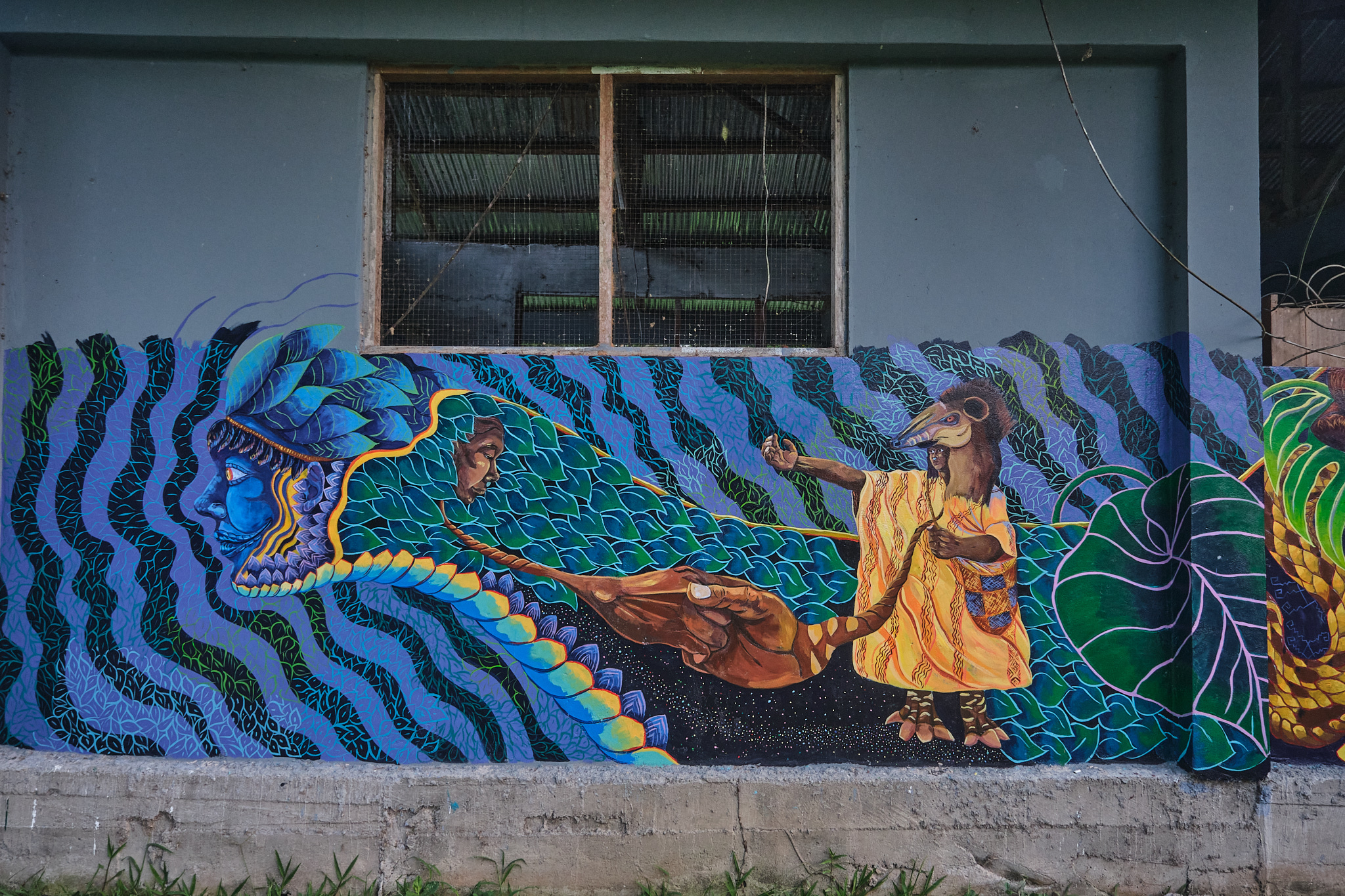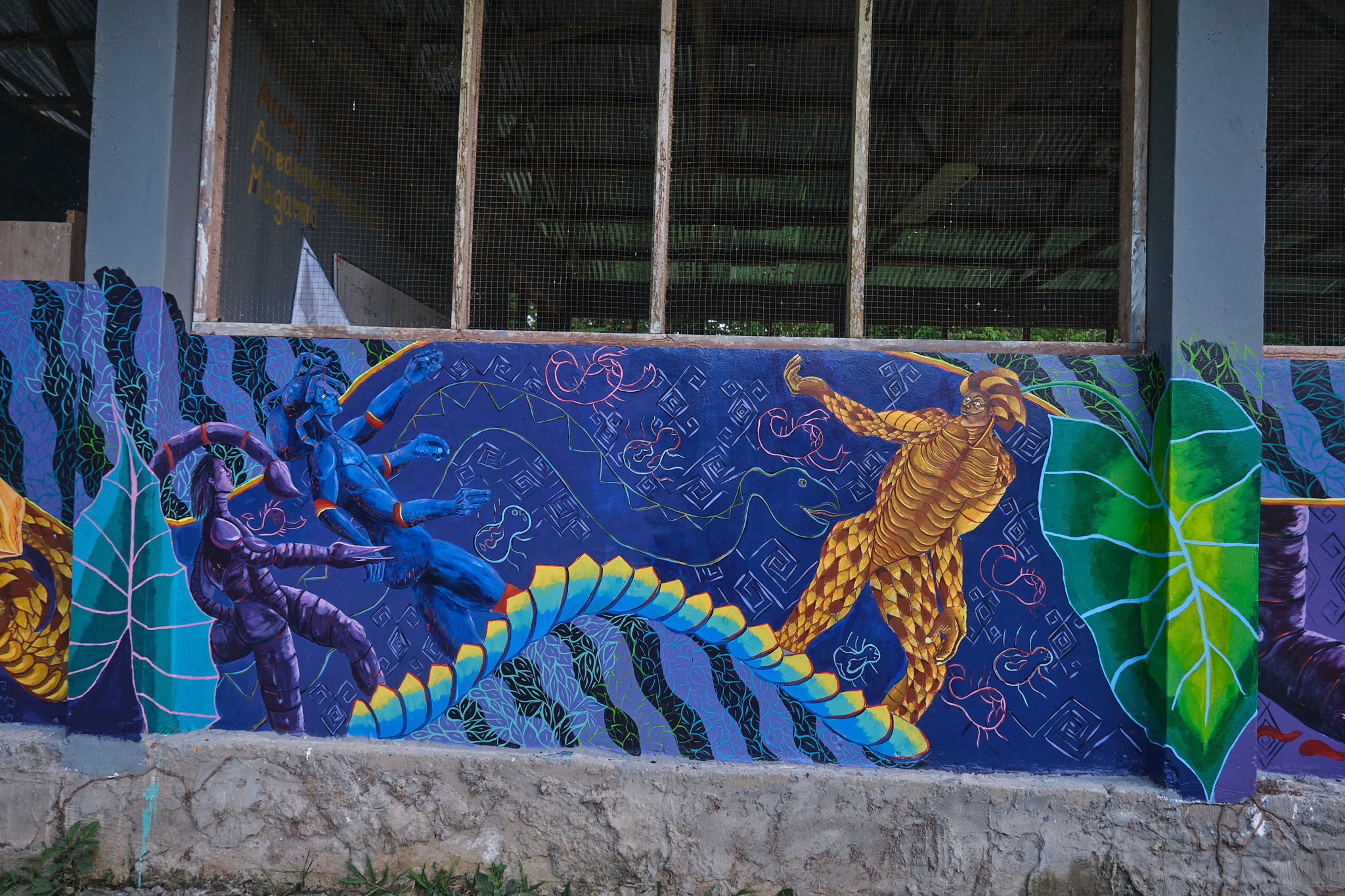A thin line between the world of animals, plants, and spirit beings.
The project of muralization for the communal hall of Shipetiari, which began last year, has officially reached its completion! This project series was led and painted by Xapiri Ground team member Davis Torres with the help of a few volunteers and members of the community. The last series of walls on the exterior of the building show an artistic depiction of 'Kenkitsarintsi Matsigenka Yatsikakerira Maranke' or 'The tale of a man who was bitten by a snake;' an ancestral story told to us by David Ríos Rivera who learned the tale from his father when he was a young boy in 1973.



The illustration that artist Davis Torres developed for this last side of the communal hall intends to explore the ancestral tale about a seripigari or shaman who ventures into the forest after having dreamt a vision from which he does not take heed and therefore encounters a snake and gets bitten. At every attempt the seripigari makes to escape from the snake; who then also converts himself into a human, he confronts various creatures who would prey on his flesh. And to them, the seripigari would appear to be a sachavaca or "tapir". In the Matsigenka world, the distinction between human and animal are situational, as the concept of other is reliant on many factors. According to traditional ethnomedical etiology, illness and other types of misfortune are often attributed to attacks by the vengeful souls of non-human “others” including game animals, plants, and spirit beings. [1]




In the end of March we presented Davis' sketches to the community and had asked David if he would tell the tale out loud. As a child the age of seven, David was transmitted this tale by his father and has since shared this story amongst his children who between themselves are only partly familiar with how it's told in its entirety for lack of repetition. This meeting gave everyone the opportunity to share their opinion on the artist's interpretation and to ask further for their participation in helping to paint it. As before, many were excited to take part, young and old. The mural attempts to convey, through artistic license, the complex stages of the story as told by the elder David Ríos Rivera and with translation assistance from Shipetiari committee members Rani and German, who also assisted in painting the mural.



The ancestral stories of the Matsigenka are metaphorical expressions of their complex relationship between nature and spirit upon which their beliefs and emotions are shaped. These tales are told over the course of a few minutes to several hours depending on the audience and the storyteller’s memory and imagination. Many elders of the community have told us how challenging it is to transmit their oral traditions to the younger generations today in light of the social pressures and technologies surrounding them.

Rani, a community elder remarks "...that which Xapiri Ground have brought to help us teach the community is to gather the stories of our ancestors to share with the children so that they don't get lost in the world and know the reality of the ancestors and the elders."

And so by means of these artistic visual interactions, these stories then come to life in a fresh way. This mural hopes to bring the value of their culture back home to them and their youth. This is the first time in the community's history to collectively realize a mural project of this scale. Read more about the full project scope here.











It has always been the intention of our work with Shipetiari to connect with the youth in creative ways through the stories, songs and wisdom of their elders. And it was interesting to discover that many in the community had not heard or been told of David's tale before, commenting that there exists a multitudinous world of stories amongst the Matsigenka. But to observe how engaged people were in listening to David nevertheless proved how powerful their oral history can be, ancestral memory is like muscle memory. The Matsigenka stories can be perceived as the fabric unto which is woven their moral codes, beliefs, and cultural behaviors. And correspondingly, the women weave various symbols and designs which are telltale of their cultural identity; a form of tactile and visual storytelling embedded in cloth.


After the completion of the final mural, members of the community were asked to sign their names on the wall inside to commemorate all of our collaborative work together, some three years in which mutual trust and confidence continue to bring us closer to the stories that shape our cultures, and most especially theirs, the Matsigenka.




We would like to thank and acknowledge the work of our colleague Davis Torres for having lead this project of visual storytelling, and we thank the community of Shipetiari for all the learnings and creative exchange for which we are all students. Thank you to all the volunteers both in and outside the community for their time and creative support in this project.
We are also grateful for the continued support of our small collective of private donors, for our ongoing alliance with the hotel Antigua Casona, for the Chacruna Institute and their contributions to our ground work, and our team at Xapiri Ground for maintaining the cultural framework upon which our commitment is rooted.
This project is made possible through our partnership with SePerú; a non-profit organization dedicated to equal benefits and co-management of Peruvian Indigenous communities and their natural ecosystem.
Support this project so that we may continue to share and learn about the ancestral knowledge of the Matsigenka people.

References:
- Revenge, Envy and Sorcery in an Amazonian Society. Carolina Izquierdo (University of California, Los Angeles) Allen Johnson (University of California, Los Angeles) Glenn H. Shepard Jr. (University of East Anglia, UK). January 2008.





